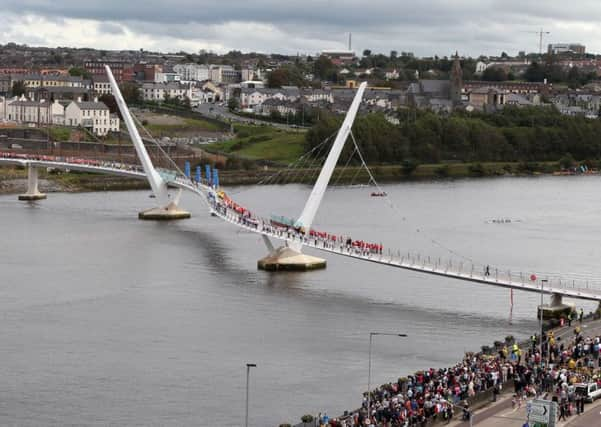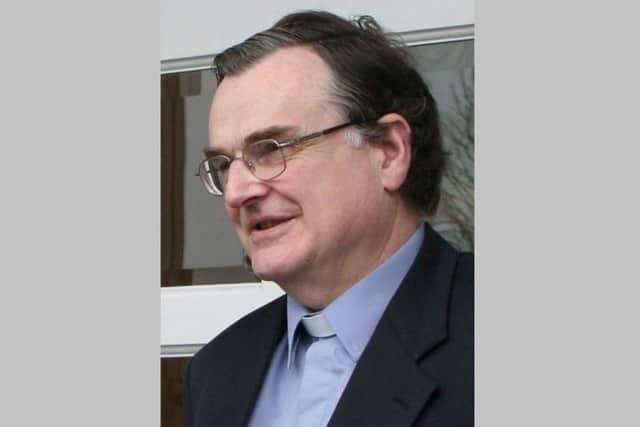Ian Ellis: A Northern Ireland to Scotland link could help in bridge building


The chair of Mid and East Antrim’s Borough Growth Committee said that the concept of a bridge between Northern Ireland and Scotland was an ambition shared by both areas, while acknowledging that it was “a long-term aspiration”.
The issue had been to the fore last year when leading architect Professor Alan Dunlop called for a serious consideration of the project by the Scottish, Irish and UK governments, suggesting two possible routes, one between Larne and Portpatrick and the other a shorter crossing between the Mull of Kintyre and Torr Head.
Advertisement
Hide AdAdvertisement
Hide AdBoris Johnson is again reported to be interested in the bridge proposal.


At an estimated cost in excess of £15 billion it would be a huge investment and the scale of the project would certainly call for a very careful cost/benefit assessment. However, Professor Dunlop said that the bridge link could bring “extraordinary benefit”.
Of course, benefit is not only to be measured in financial terms. Social benefit is immensely important and a society that enjoys good infrastructure will be more confident and at ease with itself and will be more outward and forward looking.
Bridges form an integral part of the landscape, from the small, stone bridges on country roads to the greater bridges in busy towns and cities.
Advertisement
Hide AdAdvertisement
Hide AdAmong the relatively recent bridges on this island one thinks of the inspirational Peace Bridge across the Foyle or of the landmark Mary McAleese Boyne Valley Bridge.
The former is a cycle and foot bridge and the latter is familiar to anyone who travels on the main north/south arterial road.
On my journeys this summer I visited two rather special bridges, by contrast both very ancient.
The first was the famous Pont Saint-Bénézet at Avignon in Provence in southern France, dating from the 12th century. It is also known, of course, quite simply as the Pont d’Avignon, as in the well known song.
Advertisement
Hide AdAdvertisement
Hide AdWhen it was built it was the only point between Lyon and the Mediterranean, approximately 200 miles to the south, at which the Rhône could be crossed.
However, parts of it kept collapsing due to floods and it became so expensive to maintain that what remained of it was simply left there.
Paradoxically, the now ‘half bridge’ is no doubt of huge financial benefit to the city due to its draw for tourists as a world heritage site.
The other special bridge that I came across, also a world heritage site, was the Pont du Gard, not far to the west of Avignon. It is the three-tiered aqueduct and is understood to have been built between 40 and 60AD to bring water to the Roman settlement that has become the modern city of Nîmes.
Advertisement
Hide AdAdvertisement
Hide AdThe construction is truly incredible both for its massive structure and for the precision of its design which allowed the water to flow with precisely the right force, becoming neither a waterfall nor an unreliable, trickling stream.
The aqueduct fell into disuse after the fall of the Roman Empire but in the 18th century the first tier of it was adapted as a roadway and the bridge was restored in the following century.
Bridges are of strategic social importance. They aid communication because they enable the free flow of traffic and bring people together.
There have of course always been parallels drawn between bridge building and peace building, no doubt because of the way in which bridges bring opposite, and sometimes very different, sides together.
Advertisement
Hide AdAdvertisement
Hide AdCommunity bridge building has been going on in Northern Ireland for many years, often in quiet and unobtrusive ways.
A more prominent example has been the Corrymeela Community which was founded in 1965 by the Presbyterian minister, the Rev. Ray Davey, then Presbyterian chaplain at Queen’s University, in response to his and the Presbyterian students’ observation of growing sectarianism in Northern Ireland.
Since then, there have been so many similar initiatives of that kind of bridge building in our community.
A recent further example in a wider context is well illustrated in a statement issued by Church of Ireland Bishop Paul Colton in responding to an outrageous verbal attack on a lecturer in Islamic studies at University College Cork, Amanullah De Sondy.
Advertisement
Hide AdAdvertisement
Hide AdThe Irish Examiner newspaper reported that Mr De Sondy had confirmed that he had reported an anonymous voicemail wishing for his death.
Dr Colton said that Mr De Sondy “has been a positive force for good in our community, building bridges, creating opportunities for dialogue in our new and diverse Ireland”.
Mr De Sondy’s experience was one of a series of recent anti-Muslim incidents south of the Border condemned by Church of Ireland Archbishop of Dublin Michael Jackson.
There is no reason why people should not have differences of outlook or aspiration, as long as their ideas are not prejudiced or born of hatred. Such proper diversity actually enriches life.
Advertisement
Hide AdAdvertisement
Hide AdYet, for all that legitimate diversity in our world, every person can still be a heroic bridge builder in his or her own way by bringing people together.
A bridge between Northern Ireland and Scotland could well not only serve economic development but also promote bridge building at a deeper level between all the people of these islands.
• Canon Ian Ellis is a former editor of The Church of Ireland Gazette